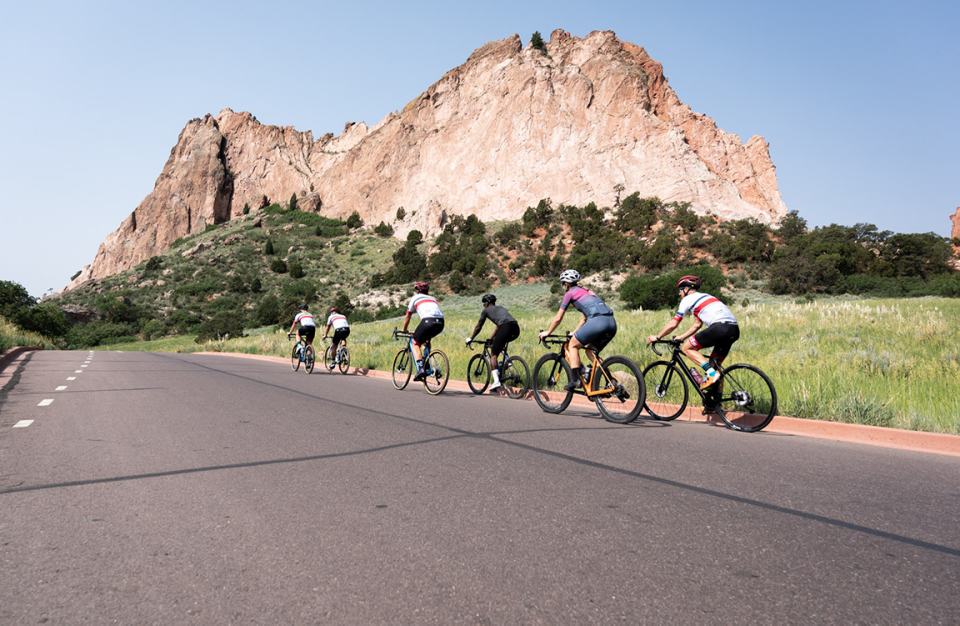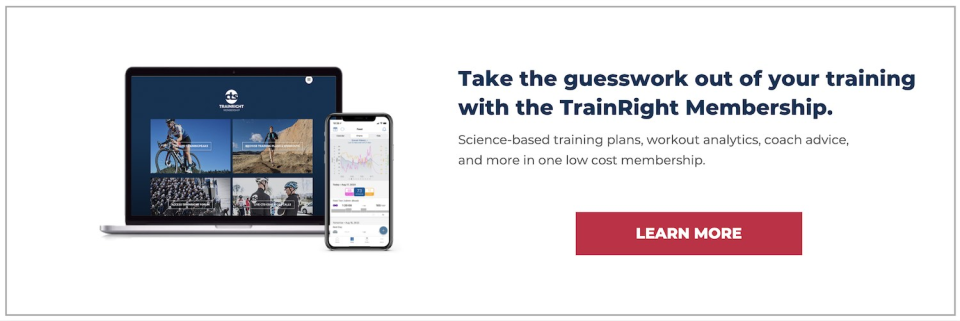Coach Renee Eastman’s Top 5 Weight Loss Mistakes for Cyclists
As athletes start new training programs, many focus on losing weight as well as achieving their best fitness. Over 20-plus years of coaching, I’ve found some common things that trip people up. Below, I’ll share 5 common mistakes I see athletes make when pursuing weight loss goals.

Before I dive into those topics, a disclaimer. Most content, including this article, is generalized advice that may or may not apply directly to you. As a Certified Sports Nutritionist through the National Academy of Sports Medicine (NASM), I’ve been coaching and consulting athletes about nutrition for decades. During that time I have observed many nutritional practices and their respective levels of success.
I have tailored the advice below to an audience I’d expect to be reading a CTS blog post. That means an amateur endurance athlete who might train on average 5-6 days a week. Daily exercise sessions are typically 2 hours or shorter, with occasional longer sessions. Although nutrition is not a one-size-fits-all subject, I hope you find these tips useful.
With that said, here’s the first mistake I often see people make when seeking advice regarding weight management:
#1 Mistake: Underfueled training and caloric overcompensation during recovery.
See if this scenario sounds familiar: After following a calorie-restricted plan all week long, you go for a big ride on Saturday. When you arrive back at home you eat everything in sight. You then spend the afternoon raiding the fridge and never seem to overcome that empty feeling.
That rebound effect commonly occurs when you create a significant and unsustainable calorie deficit. And it happens despite your best intentions to sticking to your plans. High levels of fatigue and hunger exhaust an individual’s willpower and decision-making processes.
Even without a big ride, the same thing often happens as people move through their day. People stick to a plan through the day (while they are the most active) but then go off the rails in the evening.
Finding it hard to stick to your nutrition strategy after rides or in the evenings may indicate you’re being too aggressive with your calorie deficit. Compromised training performance is an equally significant negative outcome to this pattern. This occurs because you’re going into training with low energy availability. It’s a lose-lose situation. You can end up with a net-zero on weight loss because caloric overcompensation wipes away the big calorie deficits that already ruined your training.
Caloric overcompensation as an intentional reward for hard training session is another problematic scenario I see. The thinking goes, “Hey, I just rode 4 hours, so I earned this burrito the size of my head.” Sure, recovery nutrition is important, but it’s more important to be well fueled before your training session. When you’re well fueled, you can use that energy to go harder, faster, and create a greater training stimulus. In many circumstances, eating normally after training is sufficient to refuel to recover for the next hard session. Rapid post-training replenishment is of more concern for athletes training multiple sessions a day or back-to-back days with high volume or intensity.
Another caloric overcompensation patter I see relates to misunderstanding exercise’s role in fat loss. You can’t outrun a bad diet, and that leads into the next mistake I’ll mention.
#2 Mistake: Overemphasizing the role of cardiovascular exercise in weight loss.
The idea of calories in vs. calories out for fat loss is a true but overly simplistic concept. Cardiovascular exercise expends a lot of energy and helps contribute to a caloric deficit. However, two often-overlooked factors are that most fat is burned outside of exercise, and during exercise most calories burned by endurance athletes come from carbohydrate.
You burn more fat outside of exercise
Individual athletes are more or less metabolically efficient, which alters how heavily they rely on fats for fuel at low to moderate intensity. As exercise intensity increases, so does the reliance on carbohydrate to provide energy. For most athletes riding in Zone 2 (Aerobic Endurance intensity), carbohydrate contributes about half of the energy burned. By the time intensity rises into Zone 3 (Tempo intensity), most energy is supplied by carbohydrate because energy is required faster than it can be supplied by breaking down fat. At Functional Threshold Power (FTP, lactate threshold intensity) or higher, the energy balance shifts even further to predominantly carbohydrate and very little fat.
Cardiovascular exercise is great for burning calories. However, for the most part the greatest amount of fat is burned at rest or during activities of daily living. Of course, there are exceptions. Training 3+ hours a day at low intensity may tip the balance toward more fat being used for energy in exercise vs. rest. In reality, though, high-volume low-intensity training is an uncommon scenario for most amateur and Time-Crunched Cyclists.
The impact of exercise on total daily energy expenditure
Exercise often impacts activity levels for the remainder of the day, which affects total daily energy expenditure. When I complete a big 4-hour ride, I’m less active the rest of that day and probably the next day, too. Often the days I burn the most total calories are when exercise is more moderate, but my non-exercise activity is the greatest.
I also see athletes misusing training sessions with the goal to burn off weight. It’s all about burning up extra calories on a day for them. I see athletes add extra training time, which creates junk training or, even worse, impaired recovery. The more extreme version is athletes who refuse to take days off or go easy in recovery sessions because they worry they’re burning too few calories for the day.
Here’s the dangerous mismatch of training goals: exercising just to burn calories for weight loss vs training effectively to improve fitness. Most athletes in this scenario miss the mark on both. Athletes who focus on excessive exercise to lose weight are also the ones most likely to under-fuel training. As mentioned, this often leads to caloric overcompensation later. Instead, I recommend focusing on training to improve fitness first. Sometimes that will be high-volume, low-intensity sessions. Other times that it will mean short, high-intensity work. And, of course, effective training always requires rest for maximal adaptation.
Fuel your training first
A more effective strategy utilizes fueling strategies to maximize performance. This means pre-loading training sessions for maximum effectiveness and consuming more energy before and during big training sessions. Properly fueling your training improves workout quality and makes it easier to avoid post-workout caloric overcompensation. When an athlete increases intake on harder training days they are also less likely to feel famished during the following recovery day.
Creating massive caloric deficits from under-fueling big training days makes it difficult to stay on track the long term. You’re better off creating long-term habits that support high-quality training. Short-term solutions lead to short-term results. Sure, following a trendy diet will likely result in some weight loss. But, if you can’t thrive on those dietary practices you’ll stop. Then, you’ll return to old habits that encourage weight gain.
Be patient and iterative
It’s appropriate to use a period of focused time to practice with dietary changes. You want to see what effectively supports your activity, allows you to feel good day to day, and doesn’t trigger caloric overcompensation due to persistent hunger.
#3 Mistake: Following advice that’s from dubious sources or for people with different needs.
There are many good sources of information out there and some advice might be grounded in evidence-based research and delivered by a qualified professional. The gold standard is working one-on-one with a Registered Dietician (RD). More specifically, an RD familiar with your individual needs as an athlete, your specific preferences, health history, and activity level.
However, even advice that is scientifically correct might not apply to you and your needs. What works for a sedentary individual might not be appropriate for an endurance athlete who trains 5-6 times a week. Similarly, the needs of a professional endurance athlete training 20 or 30+ hours a week would differ from an amateur training only an hour a day. And nutrition guidance changes when fueling endurance sports as opposed to strength, power, and combat sports.
The ‘diet industry’ is big business. Beware of people trying to sell the latest and greatest diet hack that promises to melt pounds away. If someone guarantees a quick fix through following their rigid rules, or eliminating whole food groups, or having to buy a bunch of specific supplements – I’d encourage you to run fast in the other direction.
The most effective advice is usually quite practical and very boring: creating long-terms habits you can sustain leads to permanent change.
#4 Weight Loss Mistake: Treating ‘a diet’ as a short-term solution.
‘Diet’ is a 4-letter word as far as I’m concerned. I often hear athletes say they need to “go on a diet to lose weight”. That indicates someone is going to follow a special nutrition routine for a designated period, then stop doing those things once the weight loss goal is achieved.
Many of the named and branded diets (Keto, Low-Carb, Low-Fat, Atkins, Zone, Intermittent Fasting, etc.) work for weight loss, as long as you stick with them. They work because they help a caloric deficit, and may result in rapid weight loss, but they are rarely sustainable for athletes. They create unsustainable calorie deficits or are deficient in macronutrients (carbohydrates specifically) needed to perform as an athlete. When athletes stop the diets, they increase calorie consumption to support their activity level, and often overcompensate, and the weight changes reverse.
Instead, I encourage people to create long-term habits that allow their weight to stabilize. Then, think of “dieting” as a focused period when they make minor adjustments to those habits. Your basic everyday habits need to be sustainable and stable, and then if you decide to temporarily lose a small amount of weight for a competition, you can do so within your known habits.
#5 Weight Loss Mistake: Taking an all-or-nothing approach.
Too many get trapped in an all-or-nothing approach to diet and exercise. When they are training consistently, they are committed to good nutrition habits and fueling strategies. During periods when they are busier with work or other life commitments, training consistency declines. So do those good nutrition habits. Of course, good nutrition is important to performance in sport, but eating wholesome and nutritious food is good for overall health and wellness all the time.
That all-or-nothing approach often contributes to caloric imbalances. That can mean a a caloric surplus during times of lower activity, which could lead to weight gain. Or, it can mean an unsustainably large caloric deficit at times of higher activity, which could lead to impaired performance or adaptation to training.
The latter is a common occurrence when athletes are starting a new program, a new season, or a New Year. To avoid this trap as we start the New Year, please do not completely change what you eat, slash your calories in half, and double your training volume.
By Renee Eastman,
CTS Premier Coach, MS, CSCS, USAC level 1, Retul, NASM
Renee Eastman is a Premier Coach for CTS with over 20 years’ experience coaching endurance sports. She has a master’s degree in Exercise Science and is a NASM certified nutrition coach.
The above is a short excerpt from the full CTS TrainRight article, to read the full article, please visit: https://trainright.com/renee-eastman-top-5-weight-loss-mistakes-for-cyclists
FREE 14 DAY MEMBERSHIP TRIAL
Gran Fondo Guide fans, click on the image above and get TrainRight Membership for a 14 day no obligation trial. TrainRight Membership comes with a 30-day money-back guarantee!
About CTS
As it has since 2000, Carmichael Training Systems leads the endurance coaching industry with proven and innovative products, services, and content. And the results speak for themselves; no other coaching company produces more champions, in such a wide variety of sports and age groups, than CTS.
For more information, please visit: https://trainright.com

